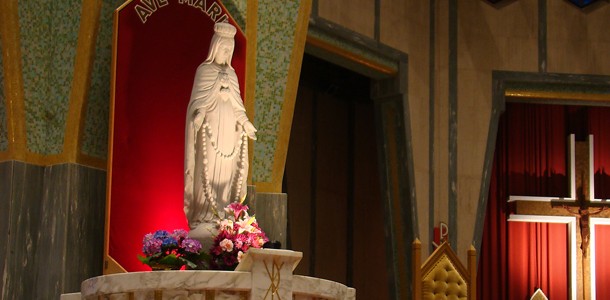

Our Lady of the Cape - Cap de la Madeleine
Salt + Light Media
Wednesday, May 9, 2012

When thinking about sites of Marian pilgrimage this May, our thoughts often fly to places overseas. Our Lady has also carved a special place for herself a little closer to home.
Lying 150 kilometers east of Montreal on the banks of the St. Lawrence River, Cap-de-la-Madeleine was used as a Jesuit missionary station as early as 1634. Three Canadian martyrs, Fathers Jean de Brebeuf, Antoine Daniel, and Gabriel Lalemant, were early residents of the area. Its first church was a modest, wooden structure of a mere 9 x 5 meters. Blessed Francois de Laval formally created the parish of Sainte-Marie-Madeleine in 1678, and the establishment of the Confraternity of the Rosary followed in 1694.
Like its closet-sized church, this confraternity was small: the group often comprised of only the Parish priest, Father Paul Vachon, and one or two members of the parish. But proving Christ’s dictum that, in matters of faith, size does not matter, this small mustard seed of a group began to lay its roots in the area. Twenty years of dedicated prayer to Our Lady resulted in the construction of a second church. In 1720, the church now known as the ‘Old Shrine’ was completed.
Things took a turn for the worse, however, when Father Vachon died. For 115 years there was no parish priest at Cap-de-la-Madeleine. When Fr. Luc Desilets arrived as a permanent pastor in 1864, he found a town wholly disinterested in the faith. For three years he struggled to bring back his parishioners in vain. It was on the Feast of the Ascension, when he discovered a pig in the church chewing a Rosary, that he found new inspiration and decided to consecrate himself and his efforts to Our Lady of the Rosary. His first step was to renew and encourage the practice of the Confraternity. Through Mary’s intercession a renewal of the faith occurred and the French settlers of the Cape required a third, larger church.
The stones for the new church were hewn and waiting on the opposite side of the St. Lawrence River. But the winter of 1879 was unseasonably mild, and the river never froze. At this impasse the parishioners began a campaign to pray the rosary unceasingly. Fr. Vachon pledged the Old Shrine to Our Lady if she would work a miracle before the winter ended. Sure enough, in mid-March and at the beginning of the spring thaw a two-kilometer bridge of ice formed across the St. Lawrence. It remained intact until the last stone was carted across. The formation of this ‘Rosary Bridge’ was, in the words of assistant pastor Eugene Duguay, “quite extraordinary, a true miracle. It defied common sense.”
Eight years later, another ‘true miracle’ was to occur on the day of the dedication of the Old Shrine to Our Lady of the Rosary. On the evening of June 22, 1888, an infirm parishioner asked Father Desilets and visiting priest Frederick Janssoone for assistance in entering the church. As the three men knelt before the statue of the Immaculate Conception, they witnessed the eyes of the statue, normally downcast, become open and living “in a most natural manner”. Following Father Desilets death later that year, Father Janssoone became the first pilgrimage director of the shrine and was beatified by Pope John Paul II on the centenary of the ‘miracle of the eyes’.
The Shrine of Our Lady of the Cape has been given the honour of being Canada’s National Shrine to Our Blessed Mother. Millions of pilgrims have passed through its gates, including Pope John Paul II who called the site “an immense grace accorded to the Canadian people”. The Old Shrine is one of the two oldest churches in Canada and the oldest in which Mass is still said daily. Its story involves many providential twists and turns, but at the heart of its events lies the unequivocal message of our heavenly advocate. The steady, reassuring presence of Mary coming through the intercession of the rosary is the true centerpiece of Canada’s Lady.
This post was written by S+L intern Karen D’Souza
Related Articles:
>>
SUPPORT LABEL
$50
$100
$150
$250
OTHER AMOUNT
DONATE
Receive our newsletters
Stay Connected
Receive our newsletters

Stay Connected









